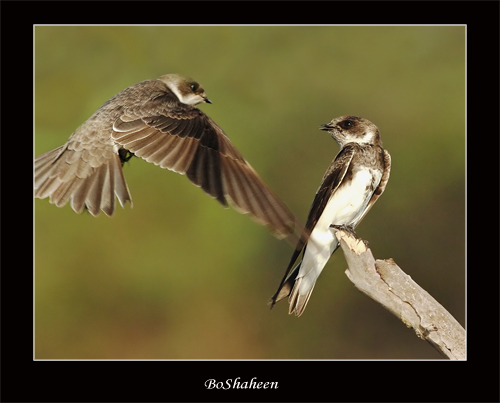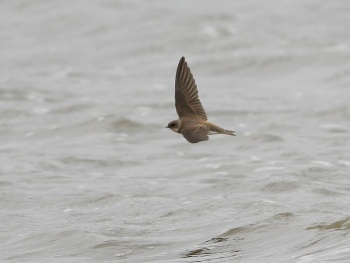(→External Links: G Search amended. Seems to be working, so Niels work-arounds deleted) |
(Copied text re-written and/or replaced by deleted text. Taxonomy expanded. References) |
||
| Line 1: | Line 1: | ||
'''Alternative names: Collared Sand Martin; Bank Swallow''' | '''Alternative names: Collared Sand Martin; Bank Swallow''' | ||
| − | [[Image:Sand_Martin.jpg|thumb|550px|right|Photo by {{user|bo+shaheen|bo shaheen}}<br /> | + | [[Image:Sand_Martin.jpg|thumb|550px|right|Photo by {{user|bo+shaheen|bo shaheen}}<br /> [[Kuwait]]]] |
;[[:Category:Riparia|Riparia]] riparia | ;[[:Category:Riparia|Riparia]] riparia | ||
==Identification== | ==Identification== | ||
| − | Length 12-13 cm | + | Length 12-13 cm<br /> |
| − | + | *Dull earthy-brown upperparts | |
| − | Juveniles | + | *White below |
| + | *Brown breast band | ||
| + | *Shallow forked tail | ||
| + | *Bill and legs are blackish-brown<br /> | ||
| + | Sexes similar<br /> | ||
| + | '''Juveniles''': tertials and upper wing coverts have pale fringes; breast band is less distinct. | ||
| + | ====Similar Species==== | ||
| + | [[Northern House Martin]] has a white rump and lacks the brown breast band; [[Barn Swallow]] has much longer tail streamers, a black breast and red throat. The [[Eurasian Crag Martin]] is larger and flies more slowly. | ||
==Distribution== | ==Distribution== | ||
| − | [[Image:Sand_Martina.jpg|thumb|350px|right|Photo by {{user|IanF|IanF}}<br /> | + | [[Image:Sand_Martina.jpg|thumb|350px|right|Photo by {{user|IanF|IanF}}<br />Saltholme East Pond. Port Clarence, Cleveland [[U.K.]]]] |
Breeds in most of the northern hemisphere, wintering to [[Africa]], southern [[Asia]] and [[South America]]. | Breeds in most of the northern hemisphere, wintering to [[Africa]], southern [[Asia]] and [[South America]]. | ||
==Taxonomy== | ==Taxonomy== | ||
| − | Five to six subspecies are recognized: ''riparia'' | + | Five to six subspecies are recognized:<sup>[[#References|[1]]]</sup><br /> |
| + | ''riparia'': breeds widely in Holarctic regions; winters in the tropics<br /> | ||
| + | ''ijimae'': Kamchatka Peninsula and Kuril Island to Amur River and Hokkaido<br /> | ||
| + | ''shelleyi'': Lower [[Egypt]] and Suez Canal region<br /> | ||
| + | ''eilata'': southern [[Israel]]<br /> | ||
| + | ''innominata'': south-eastern [[Kazakhstan]]; may winter in [[Africa]] or southern [[Asia]] | ||
| + | |||
| + | are widely recognized - ''taczanowskii'' only by some authorities. [[Pale Sand Martin]] has been split from the present species. | ||
==Habitat== | ==Habitat== | ||
| − | Riverbanks, lakesides and | + | Riverbanks, lakesides and sandpit, often seen in numbers hunting insects in low flight over lakes and rivers. Prior to and during migration they roost communally in large reedbeds |
==Behaviour== | ==Behaviour== | ||
====Diet==== | ====Diet==== | ||
The diet includes insects, such as flies and spiders that are caught in flight. | The diet includes insects, such as flies and spiders that are caught in flight. | ||
====Breeding==== | ====Breeding==== | ||
| − | + | Breeds colonially in vertical sandy or earth banks, e.g. in gravel-pits and river banks, where nest is excavated (often a good metre horizontally into the earth). | |
| + | |||
| + | The nest burrow is built by both parents; the chamber being lined with plant material and feathers. The eggs are white, and shiny. Incubation and care of the young is carried out by both parents. | ||
====Vocalisation==== | ====Vocalisation==== | ||
<flashmp3>Riparia riparia (song).mp3</flashmp3><br /> | <flashmp3>Riparia riparia (song).mp3</flashmp3><br /> | ||
''[[Media:Riparia riparia (song).mp3|Listen in an external program]]'' | ''[[Media:Riparia riparia (song).mp3|Listen in an external program]]'' | ||
| − | + | ==References== | |
| + | #{{Ref-Clements6thDec08}}#Collins Pocket Guide to British Birds 1966 | ||
| + | #Collins Field Guide 5th Edition | ||
| + | #Collins Bird Guide ISBN 0 00 219728 6 | ||
| + | #British Garden Birds | ||
| + | {{ref}} | ||
==External Links== | ==External Links== | ||
{{GSearch|Riparia_riparia}} | {{GSearch|Riparia_riparia}} | ||
Revision as of 20:57, 5 June 2009
Alternative names: Collared Sand Martin; Bank Swallow
- Riparia riparia
Identification
Length 12-13 cm
- Dull earthy-brown upperparts
- White below
- Brown breast band
- Shallow forked tail
- Bill and legs are blackish-brown
Sexes similar
Juveniles: tertials and upper wing coverts have pale fringes; breast band is less distinct.
Similar Species
Northern House Martin has a white rump and lacks the brown breast band; Barn Swallow has much longer tail streamers, a black breast and red throat. The Eurasian Crag Martin is larger and flies more slowly.
Distribution
Breeds in most of the northern hemisphere, wintering to Africa, southern Asia and South America.
Taxonomy
Five to six subspecies are recognized:[1]
riparia: breeds widely in Holarctic regions; winters in the tropics
ijimae: Kamchatka Peninsula and Kuril Island to Amur River and Hokkaido
shelleyi: Lower Egypt and Suez Canal region
eilata: southern Israel
innominata: south-eastern Kazakhstan; may winter in Africa or southern Asia
are widely recognized - taczanowskii only by some authorities. Pale Sand Martin has been split from the present species.
Habitat
Riverbanks, lakesides and sandpit, often seen in numbers hunting insects in low flight over lakes and rivers. Prior to and during migration they roost communally in large reedbeds
Behaviour
Diet
The diet includes insects, such as flies and spiders that are caught in flight.
Breeding
Breeds colonially in vertical sandy or earth banks, e.g. in gravel-pits and river banks, where nest is excavated (often a good metre horizontally into the earth).
The nest burrow is built by both parents; the chamber being lined with plant material and feathers. The eggs are white, and shiny. Incubation and care of the young is carried out by both parents.
Vocalisation
<flashmp3>Riparia riparia (song).mp3</flashmp3>
Listen in an external program
References
- Clements, JF. 2008. The Clements Checklist of Birds of the World. 6th ed., with updates to December 2008. Ithaca: Cornell Univ. Press. ISBN 978-0801445019.
- Collins Pocket Guide to British Birds 1966
- Collins Field Guide 5th Edition
- Collins Bird Guide ISBN 0 00 219728 6
- British Garden Birds
Recommended Citation
- BirdForum Opus contributors. (2024) Sand Martin. In: BirdForum, the forum for wild birds and birding. Retrieved 27 April 2024 from https://www.birdforum.net/opus/Sand_Martin
External Links





